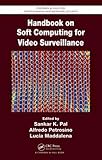Handbook on soft computing for video surveillance [electronic resource] / editors, Sankar K. Pal, Alfredo Petrosino, Lucia Maddalena.
Material type: TextSeries: Chapman & Hall/CRC cryptography and network security series ; 6Publication details: Boca Raton : CRC Press, 2012.Description: xv, 318 p., [8] p. of plates : ill. (some col.)ISBN:
TextSeries: Chapman & Hall/CRC cryptography and network security series ; 6Publication details: Boca Raton : CRC Press, 2012.Description: xv, 318 p., [8] p. of plates : ill. (some col.)ISBN: - 9781439856857 (ebook : PDF)
- Also available in print edition
Includes bibliographical references and index.
1. Introduction to video surveillance systems / Tomi D. R�aty -- 2. The role of soft computing in image analysis : rough-fuzzy approach / Alessio Ferone, Sankar K. Pal, and Alfredo Petrosino -- 3. Neural networks in video surveillance : a perspective view / Lucia Maddalena and Alfredo Petrosino -- 4. Video summarization and significance of content : a review / Rajarshi Pal, Ashish Ghosh, and Sankar K. Pal -- 5. Background subtraction for visual surveillance : a fuzzy approach / Thierry Bouwmans -- 6. Sensor and data fusion : taxonomy, challenges, and applications / Lawrence A. Klein, Lyudmila Mihaylova, and Nour-Eddin El Faouzi -- 7. Independent viewpoint silhouette-based human action modeling and recognition / Carlos Orrite ... [et al.] -- 8. Clustering for multi-perspective video analytics : a soft computing-based approach / Ayesha Choudhary, Santanu Chaudhury, and Subhashis Banerjee -- 9. An unsupervised video shot boundary detection technique using fuzzy entropy estimation of video content / Biswanath Chakraborty, Siddhartha Bhattacharyya, and Paramartha Dutta -- 10. Multi-robot and multi-camera patrolling / Christopher King ... [et al.] -- 11. A network of audio and video sensors for monitoring large environments / Claudio Piciarelli ... [et al.]
"Preface Video surveillance is the area of computer science devoted to real-time acquisition, processing, and management of videos coming from cameras installed in public and private areas, in order to automatically understand events happening at the monitored sites, eventually setting up an alarm. Because of the rapidly increasing number of surveillance cameras, it has become a key technology for security and safety, with applications ranging from fight against terrorism and crime, to private and public safety (e.g., in private buildings, transport networks, town centres, schools, and hospitals), and to the efficient management of transport networks and public facilities (e.g., traffic lights and railroad crossings). Video surveillance is an extremely interdisciplinary area, embracing the study of methods and algorithms for computer vision and pattern recognition, but also hardware for sensors and acquisition tools, computer architectures, wired and wireless communication infrastructures, and middleware. From an algorithmical standpoint, the general problem can be broken down into several steps, including motion detection, object classification, tracking, activity understanding, and semantic description, each of which poses its own challenges and hurdles for the system designers. Moreover, the scope of video surveillance is being extended to off-line multimedia analysis systems related to security and safety, thus entailing disciplines such as content-based video retrieval for visual data similarity retrieval and video mining for knowledge extraction; typical applications are in forensic video analysis and human behaviour analysis"-- Provided by publisher
Also available in print edition
Mode of access: World Wide Web
There are no comments on this title.


